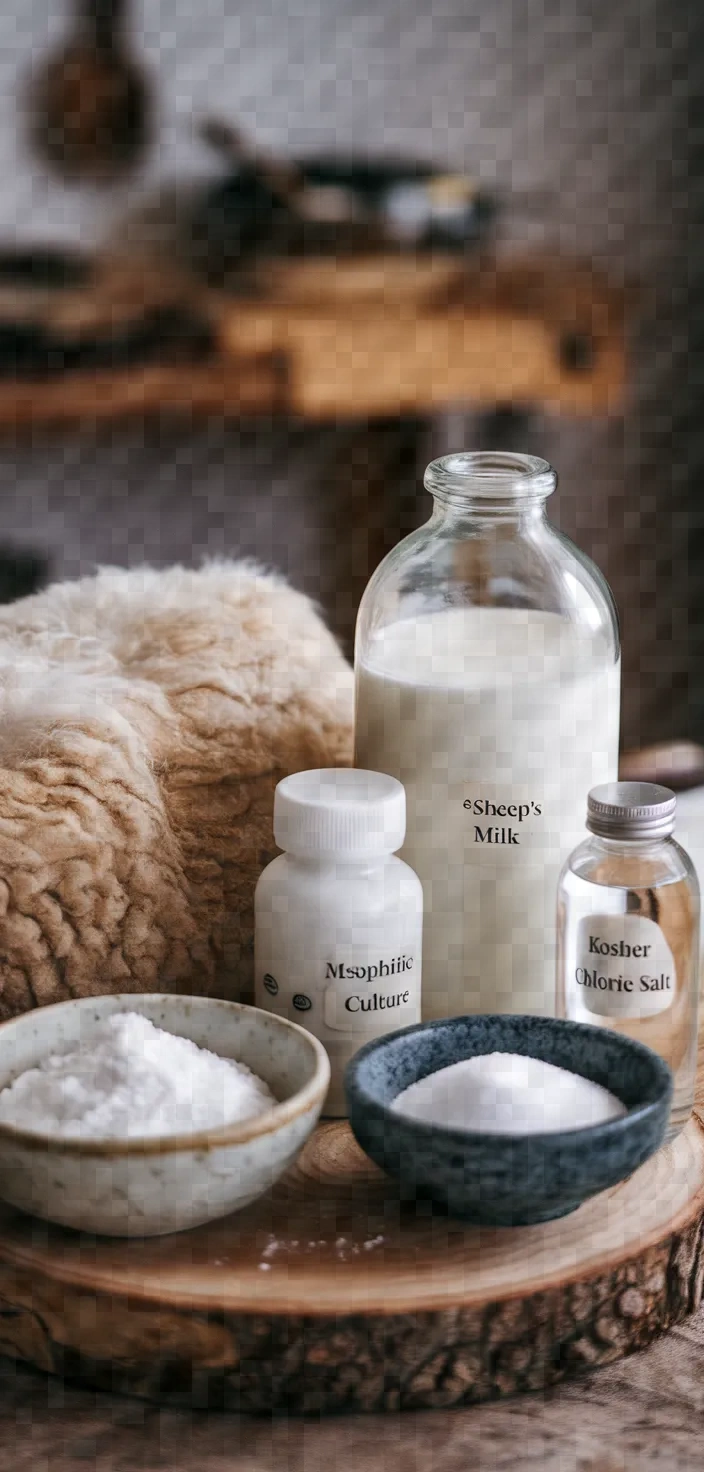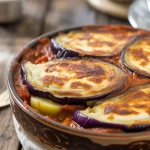Ever wonder what it’s like to nurture something from start to finish, watching it transform with just a touch of your hands and a bit of patience? Let’s dive into the artisanal magic of crafting your own sheep’s milk cheese—an experience that blends science with a sprinkle of culinary artistry.

I love creating traditional Greek flavors at home, and Kefalograviera is a delightful cheese that captures the essence of Greece. By using fresh sheep’s milk or a blend with goat’s milk, mesophilic starter culture, and a touch of rennet, this cheese offers a rich flavor profile and nutritional benefits.
Kefalograviera A Delicious Greek Cheese Recipe Ingredients

- Sheep’s Milk: Rich in protein and calcium, provides a creamy texture.
- Mesophilic Starter Culture: Begins the fermentation process, adds tangy flavor.
- Rennet: Coagulates milk proteins, essential for curd formation.
- Kosher Salt: Enhances flavor and helps preserve the cheese.
- Calcium Chloride: Improves curd quality, especially in pasteurized milk.
Kefalograviera A Delicious Greek Cheese Recipe Ingredient Quantities
- 2 gallons of fresh sheep’s milk (can substitute with a mixture of 75% sheep’s milk and 25% goat’s milk)
- 1/4 teaspoon mesophilic starter culture
- 1/4 teaspoon rennet, diluted in 1/4 cup cool, non-chlorinated water
- 1 tablespoon kosher salt
- 1/2 teaspoon calcium chloride, diluted in 1/4 cup cool, non-chlorinated water (optional, for pasteurized milk)
How to Make this Kefalograviera A Delicious Greek Cheese Recipe
1. Gently heat the sheep’s milk (or mixture) to 86°F (30°C) in a large pot, stirring occasionally to prevent scorching.
2. Sprinkle the mesophilic starter culture over the surface of the milk and let it rehydrate for 2-3 minutes. Stir gently for about 30 seconds to incorporate.
3. If using pasteurized milk, add the diluted calcium chloride to the pot and stir gently.
4. Slowly add the diluted rennet to the milk, stirring gently for about 1 minute to ensure even distribution.
5. Allow the milk to set undisturbed at 86°F (30°C) until a firm curd forms, approximately 45-60 minutes.
6. Once the curd is set, cut it into 1/2-inch cubes using a long knife, let it rest for 5 minutes to allow the curds to firm up slightly.
7. Gradually heat the curds to 105°F (40°C) while stirring gently to release whey. Maintain this temperature and stir occasionally for 30-40 minutes until the curds are firm.
8. Line a colander with cheesecloth and ladle the curds into it. Allow the whey to drain for about 5 minutes, then sprinkle the curds with kosher salt and mix gently.
9. Pack the curds into a cheese mold lined with cheesecloth. Fold the cloth over the top and press the cheese at approximately 8 lbs (
3.6 kg) for 6 hours, flipping halfway through.
10. Once pressed, remove the cheese from the mold and air dry it in a cool place for 1-2 days until the surface is dry to touch. Aging the cheese for a minimum of 3 months enhances its flavor.
Kefalograviera A Delicious Greek Cheese Recipe Equipment Needed
1. Large pot
2. Thermometer
3. Stirring spoon
4. Measuring spoons
5. Long knife
6. Colander
7. Cheesecloth
8. Ladle
9. Cheese mold
10. Cheese press
11. Small bowls (for diluting calcium chloride and rennet)
12. Weighing scale (for pressing)
13. Cooling rack or mat (for air drying)
FAQ
- Can I use cow’s milk instead of sheep’s milk? Yes, but it will alter the flavor and texture. Kefalograviera is traditionally made with sheep’s milk or a mix of sheep’s and goat’s milk for its authentic taste.
- What is the role of the mesophilic starter culture? The mesophilic starter culture acidifies the milk and helps develop the cheese’s flavor and texture during the aging process.
- Why is calcium chloride recommended for pasteurized milk? Calcium chloride is added to improve curd formation by restoring calcium levels that might be lost during pasteurization.
- Is rennet necessary for this cheese? Yes, rennet is crucial for coagulating the milk to form curd, which is necessary for making cheese.
- How long should I age Kefalograviera? Kefalograviera is typically aged for at least 3 months to develop its characteristic flavor. Longer aging will result in a stronger, more complex taste.
- Can I store the cheese at home? Yes, keep it in a cool, dry place with a consistent temperature, ideally between 50°F and 55°F (10°C to 13°C).
Kefalograviera A Delicious Greek Cheese Recipe Substitutions and Variations
- Instead of fresh sheep’s milk, use cow’s milk for a milder flavor, or a mixture of 50% goat’s milk and 50% cow’s milk for a unique taste.
- If mesophilic starter culture is unavailable, substitute with 1/4 teaspoon of yogurt with live cultures.
- Use vegetable rennet for a vegetarian option instead of animal rennet.
- Sea salt or non-iodized table salt can be used in place of kosher salt if not available.
- If calcium chloride is not at hand, omit it, but ensure you’re using non-pasteurized milk for best results.
Pro Tips
1. Ensure Proper Milk Temperature: Maintaining the milk at the right temperature is crucial for successful curd formation. Use a reliable thermometer and heat the milk slowly to precisely reach 86°F (30°C), avoiding any sudden temperature spikes that could affect the cheese texture.
2. Gentle Stirring for Even Culture Distribution: When adding the mesophilic starter culture and rennet, stir the milk gently and evenly. Vigorous stirring can disrupt the formation of a good curd, while even incorporation ensures consistent flavor development.
3. Monitor Curds for Optimal Texture: As you heat the curds to 105°F (40°C), keep a close eye on them. The curds should be firm but not rubbery. Stir gently to avoid breaking them too much, which can lead to a loss of creaminess in the final cheese.
4. Use Non-Chlorinated Water: Whether diluting rennet, calcium chloride, or any other additive, always use non-chlorinated water to prevent any interference with the cheese bacteria and curd formation, which can be affected by chlorine residues.
5. Consistent Press Pressure: Ensure the cheese press maintains a consistent pressure of approximately 8 lbs (3.6 kg). Uneven pressure can lead to irregular texture and moisture content in the cheese. If possible, use a calibrated cheese press that allows you to monitor and adjust the pressure as needed.

Kefalograviera A Delicious Greek Cheese Recipe
My favorite Kefalograviera A Delicious Greek Cheese Recipe
Equipment Needed:
1. Large pot
2. Thermometer
3. Stirring spoon
4. Measuring spoons
5. Long knife
6. Colander
7. Cheesecloth
8. Ladle
9. Cheese mold
10. Cheese press
11. Small bowls (for diluting calcium chloride and rennet)
12. Weighing scale (for pressing)
13. Cooling rack or mat (for air drying)
Ingredients:
- 2 gallons of fresh sheep’s milk (can substitute with a mixture of 75% sheep’s milk and 25% goat’s milk)
- 1/4 teaspoon mesophilic starter culture
- 1/4 teaspoon rennet, diluted in 1/4 cup cool, non-chlorinated water
- 1 tablespoon kosher salt
- 1/2 teaspoon calcium chloride, diluted in 1/4 cup cool, non-chlorinated water (optional, for pasteurized milk)
Instructions:
1. Gently heat the sheep’s milk (or mixture) to 86°F (30°C) in a large pot, stirring occasionally to prevent scorching.
2. Sprinkle the mesophilic starter culture over the surface of the milk and let it rehydrate for 2-3 minutes. Stir gently for about 30 seconds to incorporate.
3. If using pasteurized milk, add the diluted calcium chloride to the pot and stir gently.
4. Slowly add the diluted rennet to the milk, stirring gently for about 1 minute to ensure even distribution.
5. Allow the milk to set undisturbed at 86°F (30°C) until a firm curd forms, approximately 45-60 minutes.
6. Once the curd is set, cut it into 1/2-inch cubes using a long knife, let it rest for 5 minutes to allow the curds to firm up slightly.
7. Gradually heat the curds to 105°F (40°C) while stirring gently to release whey. Maintain this temperature and stir occasionally for 30-40 minutes until the curds are firm.
8. Line a colander with cheesecloth and ladle the curds into it. Allow the whey to drain for about 5 minutes, then sprinkle the curds with kosher salt and mix gently.
9. Pack the curds into a cheese mold lined with cheesecloth. Fold the cloth over the top and press the cheese at approximately 8 lbs (
3.6 kg) for 6 hours, flipping halfway through.
10. Once pressed, remove the cheese from the mold and air dry it in a cool place for 1-2 days until the surface is dry to touch. Aging the cheese for a minimum of 3 months enhances its flavor.

















